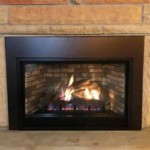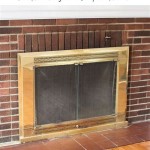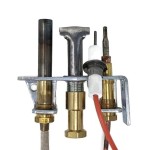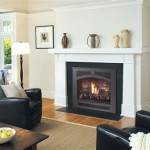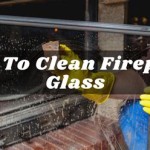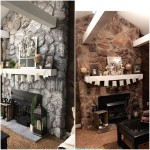Spray Painting a Gas Fireplace Insert: A Comprehensive Guide
A gas fireplace insert can be a visually appealing and functional addition to a home, providing warmth and ambiance. Over time, however, the appearance of the insert can become dated or damaged, prompting homeowners to consider cosmetic improvements. One cost-effective option is to spray paint the gas fireplace insert. This process, while seemingly straightforward, requires careful preparation, the selection of appropriate materials, and adherence to safety guidelines to ensure a successful and aesthetically pleasing outcome.
This article provides a comprehensive guide to spray painting a gas fireplace insert, covering essential considerations from preparation to application, including vital safety precautions necessary for this type of project. It is imperative to understand the specific components that can and cannot be painted, and to ensure that the paint chosen is suitable for the high temperatures generated by a gas fireplace.
Understanding the Limitations and Components
Before embarking on a spray-painting project involving a gas fireplace insert, it is crucial to identify which components can be safely and effectively painted. Not all parts of the insert are suited for this treatment, as some areas are exposed to extremely high temperatures that regular paint cannot withstand, leading to potential hazards. Generally, the metal firebox exterior, the surrounding trim, and decorative elements are amenable to painting. However, internal components directly exposed to the flames, such as the burners, logs (if applicable), or the glass viewing panel, should never be painted. Applying paint to these areas can result in the release of toxic fumes, fire hazards, and permanent damage to the fireplace insert.
Careful inspection of the insert's manufacturer specifications is paramount. The documentation often outlines permissible modifications and provides warnings about altering or painting specific components. Adhering to these guidelines is essential for maintaining the safe operation and warranty of the fireplace insert. If there is any doubt, contacting the manufacturer directly for clarification is strongly recommended. This preventative measure can save considerable time, expense, and potential safety risks associated with improper modification.
The condition of the existing finish must also be assessed. Is the existing paint flaking, peeling, or rusted? These conditions require more extensive preparation than a smooth, intact surface. Addressing existing imperfections is critical to achieving a professional and long-lasting finish. Ignoring these issues will likely result in an uneven paint application and premature failure of the new coating.
Preparation: The Key to a Successful Paint Job
Proper preparation is the cornerstone of any successful painting project, and spray painting a gas fireplace insert is no exception. A meticulous and thorough preparation process will ensure optimal paint adhesion, a smooth and uniform finish, and ultimately, a longer-lasting and visually appealing result. The preparation phase involves several critical steps that must be followed diligently.
Firstly, the gas fireplace insert should be turned off and allowed to cool completely. Disconnect the gas supply to the unit as a precautionary measure. Consult the manufacturer’s instructions for proper shut down procedures. This step is crucial for safety, preventing accidental ignition or burns during the preparation and painting process.
Next, thoroughly clean the surfaces to be painted. Use a degreasing cleaner suitable for metal surfaces to remove any dirt, grime, grease, or soot that may have accumulated. A clean surface is essential for proper paint adhesion. Rinse the surfaces with clean water and allow them to dry completely. For areas with stubborn residue, a scrub brush or abrasive pad may be necessary, but caution should be exercised to avoid scratching the existing finish.
After cleaning, mask off any areas that are not to be painted. Use painter's tape and plastic sheeting or newspaper to protect surrounding surfaces, such as walls, flooring, and any decorative elements that should not be coated with paint. Ensure the masking is secure and covers all vulnerable areas completely. Precise masking is crucial for achieving clean lines and preventing unwanted overspray.
If the existing finish is damaged, such as peeling paint or rust, it must be addressed before applying the new paint. Remove loose paint with a wire brush or sandpaper. For rust, use a rust converter or rust remover to neutralize the corrosion and prepare the surface for painting. Sanding the surface smooth after rust removal is essential for achieving a uniform finish. Feather the edges of any remaining paint to create a smooth transition between the old and new coatings. This will help to prevent the new paint from peeling or chipping in the future.
Finally, apply a primer specifically designed for high-heat applications. The primer serves as a bonding agent between the existing surface and the new paint, ensuring optimal adhesion and preventing the paint from chipping or peeling due to heat exposure. Allow the primer to dry completely according to the manufacturer's instructions before proceeding with the painting process.
Selecting the Right Paint and Application Techniques
Choosing the correct type of paint is paramount for the longevity and safety of a spray-painted gas fireplace insert. Standard paints are not suitable for this application due to the high temperatures generated by the fireplace. Using the wrong paint can lead to discoloration, cracking, peeling, and the release of potentially harmful fumes. Therefore, it is essential to select a high-heat-resistant paint specifically designed for use on fireplaces, stoves, and other high-temperature surfaces.
High-heat paints are typically available in aerosol cans for convenient application. These paints are formulated to withstand temperatures ranging from 500°F to 1200°F, depending on the specific product. Before purchasing, carefully review the product specifications to ensure that the paint is suitable for the maximum temperature that the fireplace insert will reach. Consider the paint's finish (matte, satin, or gloss) based on the desired aesthetic. Matte finishes tend to be more forgiving of imperfections, while gloss finishes offer a more reflective and modern look.
When applying the paint, work in a well-ventilated area to avoid inhaling harmful fumes. Wear a respirator mask and eye protection to protect yourself from exposure. Shake the paint can thoroughly for at least two minutes to ensure that the paint is properly mixed. Hold the can approximately 10-12 inches from the surface and apply thin, even coats, using a smooth, sweeping motion. Avoid applying thick coats, as this can lead to runs and drips. Allow each coat to dry completely before applying the next. Multiple thin coats are preferable to one thick coat, as they provide better coverage and a more durable finish.
Overlap each pass slightly to ensure complete coverage. Pay particular attention to edges and corners, which can be difficult to reach. If drips or runs occur, wipe them away immediately with a clean cloth. If the paint has already dried, lightly sand the affected area and reapply the paint. After applying the final coat, allow the paint to dry completely according to the manufacturer's instructions, typically for at least 24 hours. For optimal curing, some high-heat paints require a heat-curing process, which involves gradually increasing the temperature of the fireplace over several hours. Refer to the paint manufacturer's instructions for specific heat-curing recommendations.
After the paint has dried and cured, carefully remove the masking tape and plastic sheeting. Inspect the finished surface for any imperfections or areas that require touch-up. If necessary, apply additional paint to these areas, following the same application techniques as before. Once the touch-up work is complete, allow the paint to dry completely before reassembling the fireplace insert.
Proper disposal of used paint cans and cleaning supplies is essential. Dispose of empty paint cans according to local regulations. Do not puncture or incinerate them. Clean brushes and spray equipment with appropriate solvents and dispose of them properly. Following these steps will ensure a safe and environmentally responsible painting process.

How To Spray Paint A Brass Fireplace Insert Erfly House

Fireplace Makeover Spray Paint Magic

Diy Fireplace Makeover With High Heat Paint Jessica Welling Interiors

How To Spray Paint A Brass Fireplace Insert Erfly House

Fireplace Makeover Spray Paint Magic

How To Spray Paint A Brass Fireplace Insert Erfly House

How To Spray Paint Fireplace Interior The Diy Playbook

Painted Fireplace Insert Step By Tutorial Prodigal Pieces

How To Paint Metal Fireplace Surround Four Generations One Roof

Diy Fireplace Makeover With High Heat Paint Jessica Welling Interiors

